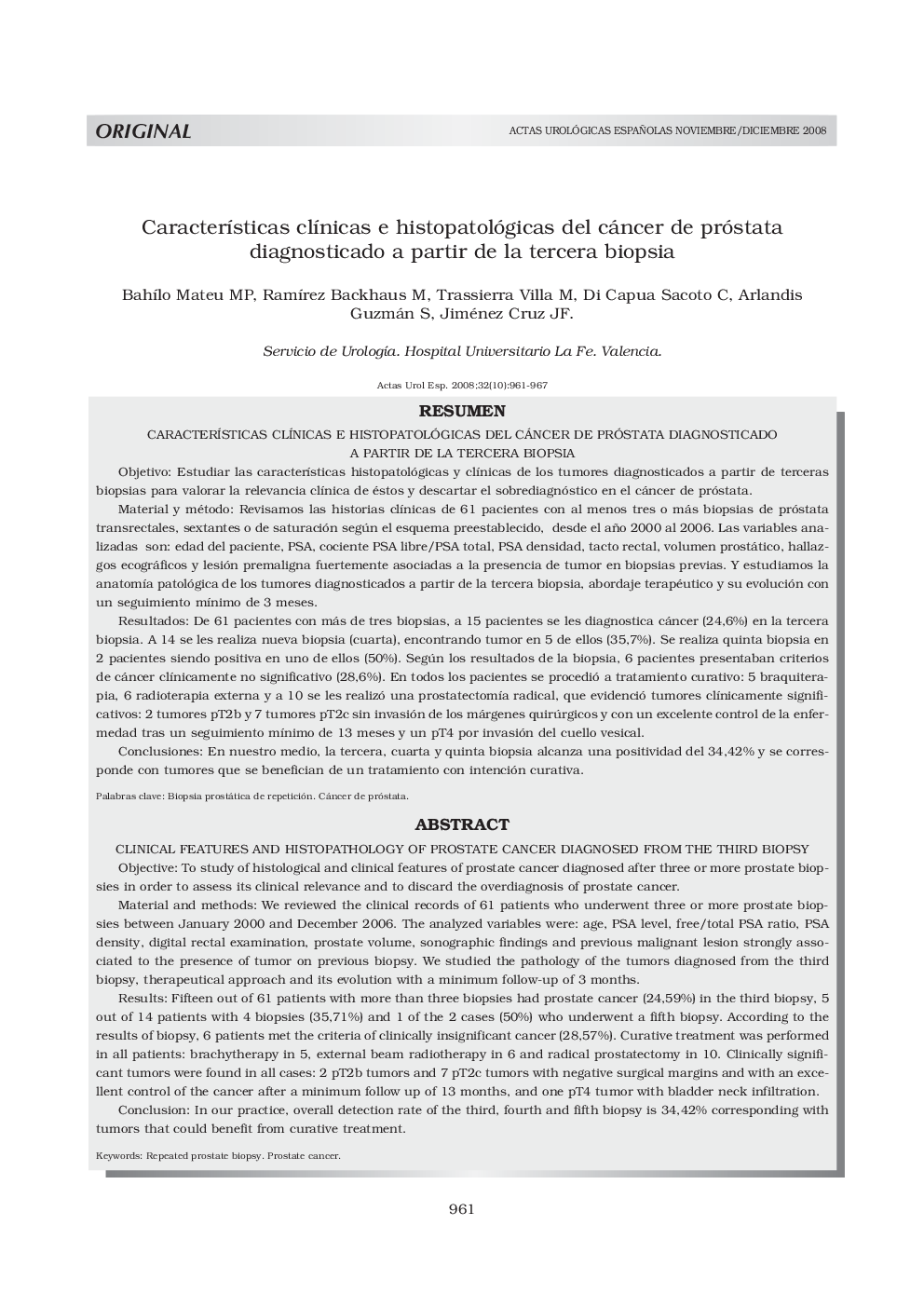| کد مقاله | کد نشریه | سال انتشار | مقاله انگلیسی | نسخه تمام متن |
|---|---|---|---|---|
| 3844260 | 1248145 | 2008 | 7 صفحه PDF | دانلود رایگان |

ResumenObjetivoEstudiar las características histopatológicas y clínicas de los tumores diagnosticados a partir de terceras biopsias para valorar la relevancia clínica de éstos y descartar el sobrediagnóstico en el cáncer de próstata.Material y métodoRevisamos las historias clínicas de 61 pacientes con al menos tres o más biopsias de próstata transrectales, sextantes o de saturación según el esquema preestablecido, desde el año 2000 al 2006. Las variables analizadas son: edad del paciente, PSA, cociente PSA libre/PSA total, PSA densidad, tacto rectal, volumen prostático, hallazgos ecográficos y lesión premaligna fuertemente asociadas a la presencia de tumor en biopsias previas. Y estudiamos la anatomía patológica de los tumores diagnosticados a partir de la tercera biopsia, abordaje terapéutico y su evolución con un seguimiento mínimo de 3 meses.ResultadosDe 61 pacientes con más de tres biopsias, a 15 pacientes se les diagnostica cáncer (24,6%) en la tercera biopsia. A 14 se les realiza nueva biopsia (cuarta), encontrando tumor en 5 de ellos (35,7%). Se realiza quinta biopsia en 2 pacientes siendo positiva en uno de ellos (50%). Según los resultados de la biopsia, 6 pacientes presentaban criterios de cáncer clínicamente no significativo (28,6%). En todos los pacientes se procedió a tratamiento curativo: 5 braquiterapia, 6 radioterapia externa y a 10 se les realizó una prostatectomía radical, que evidenció tumores clínicamente significativos: 2 tumores pT2b y 7 tumores pT2c sin invasión de los márgenes quirúrgicos y con un excelente control de la enfermedad tras un seguimiento mínimo de 13 meses y un pT4 por invasión del cuello vesical.ConclusionesEn nuestro medio, la tercera, cuarta y quinta biopsia alcanza una positividad del 34,42% y se corresponde con tumores que se benefician de un tratamiento con intención curativa.
ObjectiveTo study of histological and clinical features of prostate cancer diagnosed after three or more prostate biopsies in order to assess its clinical relevance and to discard the overdiagnosis of prostate cancer.Material and methodsWe reviewed the clinical records of 61 patients who underwent three or more prostate biopsies between January 2000 and December 2006. The analyzed variables were: age, PSA level, free/total PSA ratio, PSA density, digital rectal examination, prostate volume, sonographic findings and previous malignant lesion strongly associated to the presence of tumor on previous biopsy. We studied the pathology of the tumors diagnosed from the third biopsy, therapeutical approach and its evolution with a minimum follow-up of 3 months.ResultsFifteen out of 61 patients with more than three biopsies had prostate cancer (24,59%) in the third biopsy, 5 out of 14 patients with 4 biopsies (35,71%) and 1 of the 2 cases (50%) who underwent a fifth biopsy. According to the results of biopsy, 6 patients met the criteria of clinically insignificant cancer (28,57%). Curative treatment was performed in all patients: brachytherapy in 5, external beam radiotherapy in 6 and radical prostatectomy in 10. Clinically significant tumors were found in all cases: 2 pT2b tumors and 7 pT2c tumors with negative surgical margins and with an excellent control of the cancer after a minimum follow up of 13 months, and one pT4 tumor with bladder neck infiltration.ConclusionIn our practice, overall detection rate of the third, fourth and fifth biopsy is 34,42% corresponding with tumors that could benefit from curative treatment.
Journal: Actas Urológicas Españolas - Volume 32, Issue 10, 2008, Pages 961-967